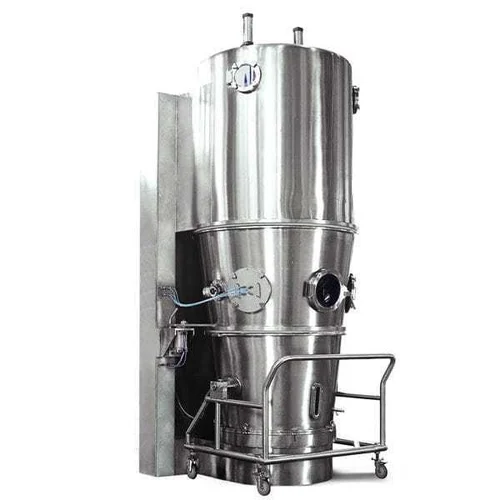
Energy Efficiency in Fluid Bed Dryers: How to Reduce Consumption
In industries where drying is a critical process, Fluid Bed Dryers (FBD) have emerged as a popular choice due to their efficiency in heat transfer, uniform drying, and scalability. However, like any industrial equipment, fluid bed dryers can be energy-intensive, which makes optimizing their energy consumption an important consideration for companies looking to reduce costs and improve environmental sustainability. This article explores various strategies to enhance the energy efficiency of Fluid Bed Dryers and minimize energy consumption without compromising performance.
Understanding Fluid Bed Dryers
Before diving into energy-saving measures, it’s essential to understand how a Fluid Bed Dryer works. Essentially, a Fluid Bed Dryer uses hot air to dry products in a bed of particles. The airflow passes through a perforated plate, causing the particles to behave like a fluid, allowing for even exposure to heat and moisture removal. This method is particularly advantageous for drying heat-sensitive materials as the drying process is gentle, and heat distribution is uniform.
Despite the advantages, the operation of a Fluid Bed Dryer requires a substantial amount of energy to maintain the required temperatures and airflow, making it necessary to focus on improving energy efficiency. By adopting several key strategies, businesses can reduce their energy consumption and simultaneously enhance the efficiency of the drying process.
Optimize Airflow and Temperature Control
One of the most significant factors affecting the energy consumption of a Fluid Bed Dryer is the airflow and temperature control. The hot air used in these systems accounts for a large portion of the energy required for the drying process. Optimizing airflow can significantly reduce energy wastage. For instance, the fan speed should be adjusted to the minimum necessary to maintain the required airflow, without excess force that would lead to additional energy consumption.
Moreover, temperature control plays a vital role. Operating the dryer at higher-than-necessary temperatures can result in excessive energy use. A common mistake is setting the drying temperature too high for the product being processed. By ensuring that the dryer operates at the most efficient temperature for the material being dried, businesses can cut down on the energy consumed by maintaining unnecessarily high temperatures.
Regular Maintenance and Cleaning
Another critical aspect of energy efficiency in Fluid Bed Dryers is ensuring that the equipment is well-maintained. Dirty filters, clogged air ducts, and other maintenance issues can cause the dryer to work harder than necessary, leading to increased energy consumption. Scheduled maintenance can prevent these issues from occurring and keep the dryer running efficiently.
For example, cleaning the air intake and exhaust systems regularly ensures that there is no obstruction in the airflow. This can help maintain optimal airflow, reduce strain on the system’s fan, and improve heat transfer efficiency. Likewise, ensuring that the components of the Fluid Bed Dryer, such as the perforated plates, are in good condition can also make a big difference in energy consumption.
Recycle Heat to Improve Energy Efficiency
Heat recovery systems are an excellent way to reduce energy consumption in Fluid Bed Dryers. Rather than releasing the hot air into the atmosphere, heat recovery systems capture and reuse the heat, reducing the need for additional heating sources. This is especially beneficial in processes where consistent temperature levels are critical.
One method of recycling heat involves using an air-to-air heat exchanger, which transfers the heat from the exhaust air back into the incoming air, pre-heating it before it enters the drying chamber. This reduces the need for heating the air from scratch and helps maintain the desired temperature without consuming additional energy.
By recycling heat in this manner, businesses can significantly lower their energy consumption, reduce costs, and also minimize the environmental impact of their operations.
Use of Energy-Efficient Components
The energy efficiency of Fluid Bed Dryers can be improved by integrating energy-efficient components into the system. One of the most important elements to consider is the dryer’s fan system. Traditional fan systems are often less energy-efficient, but by upgrading to more energy-efficient models, companies can reduce the amount of power required to circulate air within the system.
Similarly, replacing older, inefficient heating elements with newer, high-efficiency models can improve the thermal performance of the dryer. Electric heating elements that operate more efficiently can reduce energy consumption, which is particularly useful in systems where electric heat is the primary source of energy.
Monitor and Control Moisture Content
Controlling the moisture content of the material being dried can also play a crucial role in energy efficiency. By monitoring the moisture levels and adjusting the drying parameters accordingly, the Fluid Bed Dryer can operate more efficiently. If the moisture content is too high, the dryer will need to consume more energy to remove it. Conversely, drying materials that are already close to the desired moisture content will lead to unnecessary energy usage.
Implementing automated systems that continuously monitor the moisture content and adjust the dryer’s parameters can help optimize the drying process and minimize energy waste. These systems can automatically adjust airflow, temperature, and drying time based on real-time data, reducing energy consumption while ensuring the final product meets the required specifications.
Operator Training and Optimization
Finally, proper training for the operators of Fluid Bed Dryers is essential for improving energy efficiency. Operators who understand how to optimize dryer settings, monitor moisture content, and conduct regular maintenance can help reduce energy consumption. For instance, operators should be trained to adjust the dryer’s settings based on the specific properties of the material being processed, ensuring the dryer is operating at its most efficient point.
In addition, operators can help by ensuring that the Fluid Bed Dryer is not running when it is not needed. Many systems are left running unnecessarily, consuming energy even when there is no material in the drying chamber. Encouraging operators to shut down the system when it’s not in use is a simple but effective way to save energy.
Conclusion
Energy efficiency in Fluid Bed Dryers is a critical concern for many industries that rely on drying processes for their operations. By optimizing airflow, temperature control, maintenance schedules, and heat recovery systems, businesses can significantly reduce their energy consumption. Additionally, upgrading components and monitoring moisture levels can further enhance energy efficiency, while proper operator training ensures the system is run in the most optimal manner.
Through these measures, companies can not only reduce their operational costs but also contribute to environmental sustainability by minimizing energy waste. The continued focus on energy-efficient technologies and practices will help businesses maintain their competitive edge while supporting broader environmental goals.
